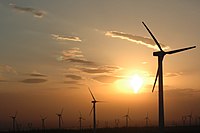
Photo from wikipedia
Full-scale wind turbine is a mature technology and therefore several retrofitting techniques have recently been spreading in the industry to further improve the efficiency of wind kinetic energy conversion. This… Click to show full abstract
Full-scale wind turbine is a mature technology and therefore several retrofitting techniques have recently been spreading in the industry to further improve the efficiency of wind kinetic energy conversion. This kind of interventions is costly and, furthermore, the energy improvement is commonly estimated under the hypothesis of ideal wind conditions, but real ones can be very different because of wake interactions and/or wind shear induced by the terrain. A precise quantification of the energy gained in real environment is therefore precious. Wind turbines are subjected to non-stationary conditions and therefore it makes little sense to compare energy production before and after an upgrade: the post-upgrade production should rather be compared to a model of the pre-upgrade production under the same conditions. Since the energy improvement is typically of the order of few percents, a very precise model of wind turbine power output is needed and therefore it should be data-driven. Furthermore, the formulation of the model is heavily affected by the features of the available data set and by the nature of the problem. The objective of this work is the discussion of some wind turbine power curve upgrades on the grounds of operational data analysis. The selected test cases are: improved start-up through pitch angle adjustment near the cut-in, aerodynamic blade retrofitting by means of vortex generators and passive flow control devices, and extension of the power curve through a soft cut-out strategy for very high wind speed. The criticality of each test case is discussed and appropriate data-driven models are formulated. These are employed to estimate the energy improvement from each of the upgrades under investigation. The general outcome of this work is a catalog of generalizable methods for studying wind turbine power curve upgrades. In particular, from the study of the selected test cases, it arises that complex wind conditions might affect wind turbine operation such that the production improvement is non-negligibly different from what can be estimated under the hypothesis of ideal wind conditions. A complex wind flow might actually impact on the efficiency of vortex generators and the soft cut-out strategies at high wind speeds. The general lesson is therefore that it is very important to estimate wind turbine upgrades on real environments through operational data.
Journal Title: Energies
Year Published: 2018
Link to full text (if available)
Share on Social Media: Sign Up to like & get
recommendations!